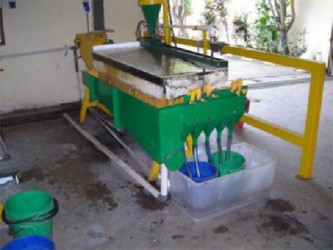Third Instalment
The Shaking Table is very common in the mining industry in French Guiana. Recently, the Correia Mining Company demonstrated the Shaking Table at its operations in Olive Creek, Mazaruni. The table deck is made of fiberglass and is supported by a steel frame. It has a longitudinal adjustable tilt; one directional shaking movement and variable speed. Water must be supplied to the table from a clean source.
The Shaking Table is capable of producing a very clean gold concentrate from gold bearing black-sand. It is highly efficient, critically, requires no mercury and costs about US$8000.00. The Shaking Table recovers gold particles down to ~325 mesh size. The most common model is the Gemini GT60 Mk2 which is designed to process up to 60lbs per hour.
CENTRIFUGES
The most suitable models for the small-scale gold mining in Guyana are the Knelson 7.5 inches and the Falcon B6. Cheaper models can be purchased in Brazil and are made of sturdier material, carbon steel. Knelson, Falcon and Knudsen centrifuges improves separation by increasing the gravitational force.

The Knelson Centrifuge operates by:
§ a ribbed rotating cone
§ slurry is fed into cone and water is also pumped in a counter flow
§ concentrate accumulates in the ribs
§ fluidized bed is created, allowing gold particles to penetrate in the concentrate layer (the rate of this penetration is improved by the rate of rotation)
Disadvantages of Centrifuges:
1. Efficient but relatively expensive
2. Requires skilled labour
3. Requires source of clean water (to achieve desired separation).
SOME DANGERS ASSOCIATED WITH THE USE OF MERCURY
Mercury emits vapour when exposed to air. When heated it turns to smoke. Mercury can get into your lungs through inhalation; it can get into your body through the skin when handled, especially where there are sores or breaks in the skin.
Mercury Contamination and the Environment
Mercury is well known as an environmental pollutant.
As soon as it is exposed, it gives off mercury vapour. It turns into fumes or smoke when heated or cooked. When blown around the atmosphere, the environment we live in absorbs these fumes and smoke.
Trees contain some mercury, which they take up from the soil. When there are large forest fires and the trees are burnt, the mercury is released into the atmosphere and then deposited into the river systems.
The mercury in the environment finally gets into the river systems when there is burning of trees and grass. The ash is washed into the rivers as rubbish and ends up in the sediments, and wildlife, or goes back to the atmosphere by evaporation. Fish and other living organisms feed on it.
People can be contaminated by mercury in a number of ways:
· When mercury is bought in large containers from wholesalers and decanted for retail sale into smaller sized bottles. Retailers “shop people” must be careful of the mercury and the mercury vapour and make sure they wash their hands immediately after pouring the mercury.
· Handling mercury with bare hands when mixing with black sand to amalgamate the gold. Rubber gloves should be worn, but if you have none, then a stick or a spoon should be used to mix the mercury with the black sand to form the amalgam.
· When squeezing the amalgam to have it ready for cooking. Again always wear gloves if possible and always make sure that you wash your hands well before starting the next activity or going to eat.
· When burning the amalgam. Always burn the amalgam outside huts so that the smoke does not get into your lungs.
· No smoking of cigarettes near the burning of the amalgam as this can increase the risk of breathing in the mercury vapour. Don’t breathe the smoke given off by the burning of amalgam.
· Do not eat food anywhere near where the amalgam is being burnt.
· Small children and women with child or pregnant women should be kept away from where the amalgam is burnt as they are the ones most at risk.
· Eating the fish caught from mercury contaminated lakes and ponds. Avoid eating fish caught from lakes or old dredging ponds that have resulted from alluvial mining activity. This also applies to rivers that pass through mining areas.





